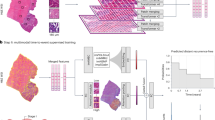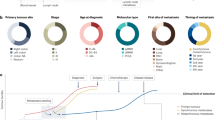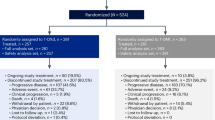Abstract
Surgery and chemotherapy form the cornerstone of the treatment for ovarian cancer. Currently, the standard of care for primary ovarian cancer is platinum and taxane-based therapy. Even among women with advanced and suboptimal disease (i.e. tumors greater than 1 cm) following surgery, the clinical efficacy of chemotherapy is noteworthy. Despite the favorable response characteristics, however, most women with advanced-stage ovarian cancer will relapse, including about 50% of women who have no evidence of disease after primary therapy. A multitude of treatment options are available at the time of recurrence, but there is no clear consensus about how these patients should be managed. Options include surgery, chemotherapy, hormones, and sometimes, radiation therapy. The sequence, combinations of treatment, and manner in which any or all of these options should be employed in an individual patient, which heretofore have not been standardized, are the subjects of ongoing clinical investigations.
Key Points
-
Unfortunately, most cases of ovarian cancer (approximately 75%) are at an advanced stage at the time of diagnosis.
-
Administration of adjuvant chemotherapy consisting of a platinum and a taxane-based regimen remains the standard front-line treatment for advanced ovarian cancer following a maximal surgical cytoreduction.
-
Unfortunately, tumors will recur in up to 70% of patients with advanced-stage ovarian or primary peritoneal cancer.
-
Treatment of recurrent ovarian cancer is often decided by the interval from previous platinum treatment; those receiving treatment within 6 months and those receiving treatment after 6 months being defined as platinum-resistant and platinum-sensitive, respectively.
-
Secondary cytoreduction might be considered in select patients with isolated masses, and a long disease-free interval of at least 12 months.
-
Future trials are needed to establish the role of molecular-targeted compounds, sequential versus combination chemotherapy, role of assay-directed therapy and secondary cytoreduction in recurrent ovarian cancer.
This is a preview of subscription content, access via your institution
Access options
Subscribe to this journal
Receive 12 print issues and online access
$209.00 per year
only $17.42 per issue
Buy this article
- Purchase on Springer Link
- Instant access to full article PDF
Prices may be subject to local taxes which are calculated during checkout
Similar content being viewed by others
References
Jemal A et al. (2006) Cancer statistics, 2006. CA Cancer J Clin 56: 106–130
Bristow RE et al. (2002) Survival effect of maximal cytoreductive surgery for advanced ovarian carcinoma during the platinum era: a meta-analysis. J Clin Oncol 20: 1248–1259
McGuire WP et al. (1996) Cyclophosphamide and cisplatin compared with paclitaxel and cisplatin in patients with stage III and stage IV ovarian cancer. N Engl J Med 334: 1–6
Ozols RF et al. (2003) Phase III trial of carboplatin and paclitaxel compared with cisplatin and paclitaxel in patients with optimally resected stage III ovarian cancer: a Gynecologic Oncology Group study. J Clin Oncol 21: 3194–3200
Vasey PA et al. (2004) Phase III randomized trial of docetaxel-carboplatin versus paclitaxel-carboplatin as first-line chemotherapy for ovarian carcinoma. J Natl Cancer Inst 96: 1682–1691
Alberts DS et al. (1996) Intraperitoneal cisplatin plus intravenous cyclophosphamide versus intravenous cisplatin plus intravenous cyclophosphamide for stage III ovarian cancer. N Engl J Med 335: 1950–1955
Markman M et al. (2001) Phase III trial of standard-dose intravenous cisplatin plus paclitaxel versus moderately high-dose carboplatin followed by intravenous paclitaxel and intraperitoneal cisplatin in small-volume stage III ovarian carcinoma: an intergroup study of the Gynecologic Oncology Group, Southwestern Oncology Group, and Eastern Cooperative Oncology Group. J Clin Oncol 19: 1001–1007
Armstrong D et al. (2006) Intraperitoneal cisplatin and paclitaxel in ovarian cancer. N Engl J Med 354: 34–43
Markman M et al. (2003) Phase III randomized trial of 12 versus 3 months of maintenance paclitaxel in patients with advanced ovarian cancer after complete response to platinum and paclitaxel-based chemotherapy: a Southwest Oncology Group and Gynecologic Oncology Group trial. J Clin Oncol 21: 2460–2465
Markman M et al. (1991) Second-line platinum therapy in patients with ovarian cancer previously treated with cisplatin. J Clin Oncol 9: 389–393
Markman M and Bookman MA (2000) Second-Line treatment of ovarian cancer. Oncologist 5: 26–35
Rosenberg P et al. (2002) Randomized trial of single agent paclitaxel given weekly versus every three weeks and with pre-oral versus intravenous steroid premedication to patients with ovarian cancer previously treated with platinum. Acta Oncol 2002 41: 418–424
Herzog TJ (2004) Recurrent ovarian cancer: how important is it to treat to disease progression? Clin Cancer Res 10: 7439–7449
Markman M et al. (2004) Liposomal anthracycline treatment for ovarian cancer. Sem Oncol 31 (Suppl 13): 91–105
O'Byrne KJ et al. (2002) A phase III study of Doxil/Caelyx versus paclitaxel in platinum-treated, taxane-naive relapsed ovarian cancer [abstract]. Proc Am Soc Clin Oncol 21: a808
Gordon N et al. (2001) Recurrent epithelial ovarian carcinoma: a randomized phase III study of pegylated liposomal doxorubicin versus topotecan. J Clin Oncol 19: 3312–3322
Gordon AN et al. (2004) Long-term survival advantage for women treated with pegylated liposomal doxorubicin compared with topotecan in a phase 3 randomized study of recurrent and refractory epithelial ovarian cancer. Gynecol Oncol 95: 1–8
Kudelka AP et al. (1996) Phase II study of intravenous topotecan as a 5-day infusion for refractory epithelial ovarian carcinoma. J Clin Oncol 14: 1552–1557
Creemers GJ et al. (1996) Topotecan, an active drug in the second-line treatment of epithelial ovarian cancer: results of a large European phase II study. J Clin Oncol 14: 3056–3061
Swisher EM et al. (1997) Topotecan in platinum- and paclitaxel-resistant ovarian cancer. Gynecol Oncol 66: 480–486
Levy T et al. (2004) Phase II study of weekly topotecan in patients with recurrent or persistent epithelial ovarian cancer. Gynecol Oncol 95: 686–690
Markman M et al. (2003) Phase 2 trial of single-agent gemcitabine in platinum-paclitaxel refractory ovarian cancer. Gynecol Oncol 90: 593–596
Lund B et al. (1995) Phase II study of gemcitabine in previously platinum-treated ovarian cancer patients. Anticancer Drugs 6 (Suppl 6): 61–62
Shapiro JD et al. (1996) Activity of gemcitabine in patients with advanced ovarian cancer: responses seen following platinum and paclitaxel. Gynecol Oncol 63: 89–93
Rose PG et al. (2003) Gemcitabine reverses cisplatin resistance: demonstration of activity in platinum- and multidrug-resistant ovarian and peritoneal carcinoma. Gynecol Oncol 88: 17–21
Schink JC et al. (1995) Altretamine (Hexalen) An effective salvage chemotherapy after paclitaxel (Taxol) in women with recurrent platinum resistant ovarian cancer [abstract]. Proc Am Soc Clin Oncol 14: a770
Markman M et al. (1998) Altretamine (hexamethylmelamine) in platinum-resistant and platinum-refractory ovarian cancer: a Gynecologic Oncology Group phase II trial. Gynecol Oncol 69: 226–229
Rose PG et al. (1998) Prolonged oral etoposide as second line therapy for platinum resistant and platinum sensitive ovarian carcinomas: a Gynecologic Oncology Group study. J Clin Oncol 16: 405–410
Markman M et al. (1992) Ifosfamide and mesna in previously treated advanced epithelial ovarian cancer: activity in platinum-resistant disease. J Clin Oncol 10: 243–248
Markman M et al. (1996) Tamoxifen in platinum-refractory ovarian cancer: a Gynecologic Oncology Group ancillary report. Gynecol Oncol 62: 4–6
Boehmer CH and Jaeger W (2002) Capecitabine in treatment of platinum-resistant recurrent ovarian cancer. Anticancer Res 22: 439–443
Bajetta E et al. (1996) Phase II study of vinorelbine in patients with pretreated advanced ovarian cancer: activity in platinum-resistant disease. J Clin Oncol 14: 2546–2551
Rose PG et al. (2003) A phase II study of docetaxel in paclitaxel-resistant ovarian and peritoneal carcinoma: a Gynecologic Oncology Group study. Gynecol Oncol 88: 130–135
Hurwitz H et al. (2004) Bevacizumab plus irinotecan, fluorouracil, and leucovorin for metastatic colorectal cancer. N Engl J Med 350: 2335–2342
Ignoffo RJ (2004) Overview of bevacizumab: a new cancer therapeutic strategy targeting vascular endothelial growth factor. Am J Health Syst Pharm 61: S21–S26
Burger RA et al. (2005) Phase II trial of bevacizumab in persistent or recurrent epithelial ovarian cancer (EOC) or primary peritoneal cancer (PPC): a Gynecologic Oncology Group (GOG) study [abstract]. Proc Am Soc Clin Oncol 24: a5009
Bookman MA et al. (2003) Evaluation of monoclonal humanized anti-HER2 antibody, trastuzumab, in patients with recurrent or refractory ovarian or primary peritoneal carcinoma with overexpression of HER2: a phase II trial of the Gynecologic Oncology Group. J Clin Oncol 21: 283–290
Aghajanian C (2004) Clinical update: novel targets in gynecologic malignancies. Semin Oncol 31 (Suppl 16): 22–26
Tew KD (2005) TLK-286: a novel glutathione S-transferase-activated prodrug. Expert Opin Investig Drugs 14: 1047–1054
D'Incalci M et al. (2003) The combination of yondelis and cisplatin is synergistic against human tumor xenografts. Eur J Cancer 39: 1920–1926
Markman M et al. (2004) Survival following the documentation of platinum and taxane resistance in ovarian cancer: a single institution experience involving multiple phase 2 clinical trials. Gynecol Oncol 93: 699–701
Pfisterer J et al. (2004) Gemcitabine/carboplatin (GC) vs. carboplatin (C) in platinum sensitive recurrent ovarian cancer (OVCA). Results of a Gynecologic Cancer Intergroup randomized phase III trial of the AGO OVAR, the NCIC CTG and the EORTC GCG [abstract]. Proc Am Soc Clin Oncol 23: a449
Parmar MK et al. (2003) Paclitaxel plus platinum-based chemotherapy versus conventional platinum-based chemotherapy in women with relapsed ovarian cancer: the ICON4/AGO-OVAR-2.2 trial. Lancet 361: 2099–2106
Chambers SK et al. (1988) Evaluation of the role of second-look surgery in ovarian cancer. Obstet Gynecol 72: 404–408
Podratz KC et al. (1988) Evaluation of treatment and survival after positive second-look laparotomy. Gynecol Oncol 31: 9–24
Hoskins WJ et al. (1989) Influence of secondary cytoreduction at the time of second-look laparotomy on the survival of patients with epithelial ovarian carcinoma. Gynecol Oncol 134: 365–371
McCreath WA and Chi DS (2004) Surgical cytoreduction in ovarian cancer. Oncology 18: 645–653
Thomas GM and Dembo AJ (1993) Integrating radiation therapy into the management of ovarian cancer. Cancer 71: 1710–1718
Yap OW et al. (2005) Intraoperative radiation therapy in recurrent ovarian cancer. Int J Radiat Oncol Biol Phys 63: 1114–1121
Author information
Authors and Affiliations
Corresponding author
Ethics declarations
Competing interests
TJ Herzog declared he is a consultant for and has received research support from GlaxoSmith Kline, Orthobiotech, Sanofi Aventis and Lilly. B Pothuri declared she has no competing interests.
Rights and permissions
About this article
Cite this article
Herzog, T., Pothuri, B. Ovarian cancer: a focus on management of recurrent disease. Nat Rev Clin Oncol 3, 604–611 (2006). https://doi.org/10.1038/ncponc0637
Received:
Accepted:
Issue Date:
DOI: https://doi.org/10.1038/ncponc0637
This article is cited by
-
Multimerin 1 aids in the progression of ovarian cancer possibly via modulation of DNA damage response and repair pathways
Molecular and Cellular Biochemistry (2023)
-
Cyclin H predicts the poor prognosis and promotes the proliferation of ovarian cancer
Cancer Cell International (2020)
-
CTLA-4 blockade boosts the expansion of tumor-reactive CD8+ tumor-infiltrating lymphocytes in ovarian cancer
Scientific Reports (2020)
-
Next-generation sequencing-based genomic profiling analysis reveals novel mutations for clinical diagnosis in Chinese primary epithelial ovarian cancer patients
Journal of Ovarian Research (2019)
-
MICU1 drives glycolysis and chemoresistance in ovarian cancer
Nature Communications (2017)



